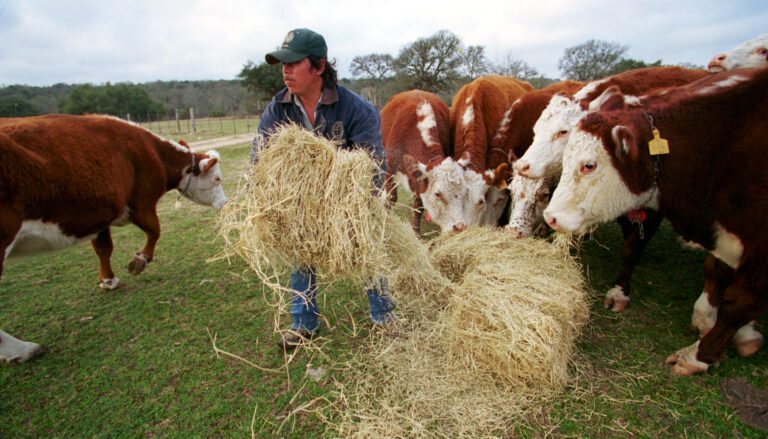Rising Beef Prices in the U.S.: Understanding the Factors Behind the Surge
In recent months, beef prices in the United States have reached unprecedented levels. In June, consumers faced an average price of $6.12 per pound for ground beef, a significant hike fueled by a dwindling cattle supply. Notably, steak prices also surged by 8% compared to last year. Compounding the issue, the nation’s cattle herd has dwindled to 94.2 million head, the lowest count for July since record-keeping began in 1973.
What’s Driving the Price Increase?
Despite rising costs for consumers and tightening profit margins for ranchers, major processors in the beef industry continue to report healthy profits. This situation raises questions about who truly benefits from the ongoing beef shortage.
“Supplies are tight compared with demand, leading to record-high prices for cattle and beef,” states Derrell Peel, an agribusiness professor at Oklahoma State University. “This situation has been developing for several years, but consumers are only now fully realizing the impact.”
Addressing Vulnerabilities: The Pandemic Response
The COVID-19 pandemic exposed significant vulnerabilities in America’s meat supply chain, as major meatpacking plants were forced to shut down. In response, the U.S. Department of Agriculture (USDA) launched a $500 million initiative in July 2021 aimed at expanding the capacities of smaller processing plants.
USDA Initiatives
The USDA has implemented several programs in 2023 to support these efforts:
- Local Meat Capacity Grant Program: Over $55 million has been allocated, leading to 660 jobs created and benefits for nearly 8,000 producers.
- Meat and Poultry Inspection Readiness Grant Program: $54.6 million has bolstered 237 facilities, enabling 118 to ship products across state lines.
- Local Agriculture Market Program: $5 million in projects aimed at strengthening processing across 14 states.
The Continuing Challenge
Despite these efforts, the structural dominance of the industry’s "Big Four" – Tyson, JBS, Cargill, and National Beef – remains intact, as they control approximately 85% of fed-cattle processing in the U.S. Smaller processors find it increasingly challenging to compete due to limited labor, high borrowing costs, and the ongoing decline in the national herd.
"The big companies seem intent on squashing the additional estimated 10,000 head per day expansion stimulated by the USDA grants," explains Steven Whitmire, CEO of Brasstown Beef.
Financial Disparities in the Beef Industry
Profit Margins and Market Dynamics
Major players like JBS S.A., the world’s largest meat company, reported an astounding $21 billion in net revenue for Q2 2025. While its North American beef division faced struggles due to a tight cattle supply, the company balanced losses with profits from its diversified operations in poultry, pork, and international markets.
This ability to manage losses through other sectors is not available to smaller meat processors, which amplifies the competitive disadvantages they face.
Consumer Demand Remains Firm
Despite inflated prices and declining supply, demand for beef remains robust. Many consumers continue to favor premium cuts, driven by campaigns like the “Make America Healthy Again” initiative, which promotes red meat consumption.
The Impact of Imports on Domestic Supply
As domestic supplies decrease, the reliance on imported beef has risen significantly. In 2022, approximately 22% of the beef consumed in the U.S. was imported.
"This is a threat to our national security," warns Bill Bullard, a former cattle industry attorney. "Global packers benefit from exporting U.S. beef while simultaneously supplying domestic markets with cheaper imported beef."
Key Import Sources
- Australia remains a significant supplier, although it can’t fully compensate for U.S. demand.
- Canada and Mexico contribute notable quantities, particularly ground beef, though tariffs may limit imports.
Supply Chain Adjustments
The recent suspension of feeder cattle imports from Mexico due to health concerns has further tightened the U.S. cattle supply. However, processors have begun supplementing with foreign beef, particularly for ground beef, resulting in higher prices for that specific cut.
Why the Cattle Herd Isn’t Rebuilding
The longstanding decline in the U.S. cattle herd can largely be attributed to the inherent cattle cycle. Years of drought, particularly in the western regions, have forced ranchers to cull heifers intended for breeding, exacerbating the shortage.
Pressures on Ranchers
- Improving moisture conditions in some regions have not outweighed the high interest rates and capital requirements, which discourage ranchers from retaining heifers for herd expansion.
- The immediate financial calculus pushes many ranchers to sell calves instead of holding them for future growth.
Whitmire asserts, “Until prices are reduced, you will not see herd building take effect.”
The Way Forward: Policy Recommendations
While the USDA’s $500 million investment aimed to bolster smaller processors, the continued dominance of the largest players hampers market competitiveness.
Bullard suggests measures that could address these imbalances:
- Reinstating mandatory country-of-origin labeling
- Broadening tariffs on foreign beef
- Enforcing antitrust laws to break up concentrated market control
These interventions may facilitate herd rebuilding and reduce reliance on imports, but given the extensive biological cycles involved, substantial change is projected to take several years.
Conclusion: The Future of Beef Prices
The current surge in beef prices reflects a complex interplay of limited supply and steady demand.
"It’s a combination of fewer cattle and profits in the feeder sector," notes Whitmire. “Until the herd rebuilds and competition is restored, the advantages will likely continue to favor the largest industry players, while both ranchers and consumers bear the brunt of high prices.”
As the situation unfolds, significant changes in policy and market dynamics may shape the future of the U.S. beef industry, providing hope for a more competitive landscape.
For further information on beef pricing and industry trends, you can access resources such as the USDA and agricultural market analysis platforms to stay updated on these significant developments.


